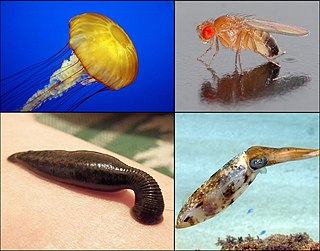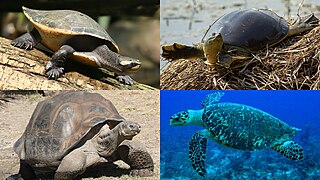
Invertebrates are animals that neither possess nor develop a vertebral column, derived from the notochord. This includes all animals apart from the chordate subphylum Vertebrata. Familiar examples of invertebrates include arthropods, mollusks, annelid, and cnidarians.

Turtles are an order of reptiles known as Testudines, characterized by a shell developed mainly from their ribs. Modern turtles are divided into two major groups, the side-necked turtles and hidden neck turtles which differ in the way the head retracts. There are 360 living and recently extinct species of turtles, including tortoises and terrapins. They are found on most continents, some islands and much of the ocean. Like other reptiles, birds, and mammals, they breathe air and do not lay eggs underwater, although many species live in or around water. Genetic evidence typically places them in close relation to crocodilians and birds.

The Sipuncula or Sipunculida is a group containing about 162 species of bilaterally symmetrical, unsegmented marine worms. The name Sipuncula is from the genus name Sipunculus, and comes from the Latin siphunculus meaning a "small tube". Sipuncula seems to be closely related to Myzostomida, and Annelida.

The Echiura, or spoon worms, are a small group of marine animals. Once treated as a separate phylum, they are now considered to belong to Annelida. Annelids typically have their bodies divided into segments, but echiurans have secondarily lost their segmentation. The majority of echiurans live in burrows in soft sediment in shallow water, but some live in rock crevices or under boulders, and there are also deep sea forms. More than 230 species have been described. Spoon worms are cylindrical, soft-bodied animals usually possessing a non-retractable proboscis which can be rolled into a scoop-shape to feed. In some species the proboscis is ribbon-like, longer than the trunk and may have a forked tip. Spoon worms vary in size from less than a centimetre in length to more than a metre.

Marine mammals are aquatic mammals that rely on the ocean and other marine ecosystems for their existence. They include animals such as seals, whales, manatees, sea otters and polar bears. They are an informal group, unified only by their reliance on marine environments for feeding and survival.

Allopatric speciation – also referred to as geographic speciation, vicariant speciation, or its earlier name the dumbbell model – is a mode of speciation that occurs when biological populations become geographically isolated from each other to an extent that prevents or interferes with gene flow.

Paraponera clavata is a species of ant, commonly known as the bullet ant, named for its extremely painful sting. It inhabits humid lowland rainforests in Central and South America.

The Cuvier's beaked whale or goose-beaked whale is the most widely distributed of all beaked whales in the family Ziphiidae. It is smaller than most baleen whales yet large among beaked whales. Cuvier's beaked whale is pelagic, inhabiting waters deeper than 1,000 feet (300 m). It has the deepest and longest recorded dives among whales at 9,816 feet (2,992 m) and 222 minutes respectively, though the frequency and reasons for these extraordinary dives are unclear. Despite its deep water habitat, it is one of the most frequently spotted beached whales.

Oligochaeta is a subclass of animals in the phylum Annelida, which is made up of many types of aquatic and terrestrial worms, including all of the various earthworms. Specifically, oligochaetes comprise the terrestrial megadrile earthworms, and freshwater or semiterrestrial microdrile forms, including the tubificids, pot worms and ice worms (Enchytraeidae), blackworms (Lumbriculidae) and several interstitial marine worms.

Parrotfishes are a group of about 90 fish species regarded as a family (Scaridae), or a subfamily (Scarinae) of the wrasses. With about 95 species, this group's largest species richness is in the Indo-Pacific. They are found in coral reefs, rocky coasts, and seagrass beds, and can play a significant role in bioerosion.

Poison dart frog is the common name of a group of frogs in the family Dendrobatidae which are native to tropical Central and South America. These species are diurnal and often have brightly colored bodies. This bright coloration is correlated with the toxicity of the species, making them aposematic. Some species of the family Dendrobatidae exhibit extremely bright coloration along with high toxicity, while others have cryptic coloration with minimal to no amount of observed toxicity. The species that have great toxicity derive this from their diet of ants, mites and termites. Other species however, that exhibit cryptic coloration and low to no amounts of toxicity, eat a much larger variety of prey. Many species of this family are threatened due to human infrastructure encroaching on their habitats.

Euspira heros, the northern moon snail, is a species of large sea snail in the family Naticidae. This large snail is rather uncommon intertidally, but is much more common subtidally. This species, like all moon snails, feeds voraciously on clams and other snails.

Serpula is a genus of sessile, marine annelid tube worms that belongs to the family Serpulidae. Serpulid worms are very similar to tube worms of the closely related sabellid family, except that the former possess a cartilaginous operculum that occludes the entrance to their protective tube after the animal has withdrawn into it. The most distinctive feature of worms of the genus Serpula is their colorful fan-shaped "crown". The crown, used by these animals for respiration and alimentation, is the structure that is most commonly seen by scuba divers and other casual observers.
Janua pagenstecheri is a species of marine polychaete. It is widely distributed around the British Isles and across north-western Europe, and has been described as "probably the commonest spirorbid in the world".

Ecological speciation is a form of speciation arising from reproductive isolation that occurs due to an ecological factor that reduces or eliminates gene flow between two populations of a species. Ecological factors can include changes in the environmental conditions in which a species experiences, such as behavioral changes involving predation, predator avoidance, pollinator attraction, and foraging; as well as changes in mate choice due to sexual selection or communication systems. Ecologically-driven reproductive isolation under divergent natural selection leads to the formation of new species. This has been documented in many cases in nature and has been a major focus of research on speciation for the past few decades.

The annelids, also known as the ringed worms or segmented worms, are a large phylum, with over 22,000 extant species including ragworms, earthworms, and leeches. The species exist in and have adapted to various ecologies – some in marine environments as distinct as tidal zones and hydrothermal vents, others in fresh water, and yet others in moist terrestrial environments.

Orbicella is a genus of stony corals in the Merulinidae family. The Orbicella species complex comprises three sister species, namely Orbicella faveolata, Orbicella annularis and Orbicella franksi, all of which are shallow-water, zooxanthellate species and are native to the tropical western Atlantic Ocean, the Caribbean Sea and the Gulf of Mexico.
Salvatoria pilkena is a species belonging to the phylum Annelida, a group known as the segmented worms. The species name comes from an Aboriginal word, pilkena, meaning "different", due to its characteristic features. Salvatoria pilkena belongs to a reduced group of species that possess rugose dorsal cirri, contrary to the typical spindle-shaped cirri found in its genus. It also lacks dorsal cirri on chaetiger 2. It resembles Salvatoria swedmarki and S. celiae, differing from pilkena in that the latter has significantly longer proventricles, while its compound chaetae are short and unidentate. At the same time, S. opisthodentata has a similar body and compound chaetae but appears to possess dorsal cirri on its chaetiger 2.

Reinforcement is a process of speciation where natural selection increases the reproductive isolation between two populations of species. This occurs as a result of selection acting against the production of hybrid individuals of low fitness. The idea was originally developed by Alfred Russel Wallace and is sometimes referred to as the Wallace effect. The modern concept of reinforcement originates from Theodosius Dobzhansky. He envisioned a species separated allopatrically, where during secondary contact the two populations mate, producing hybrids with lower fitness. Natural selection results from the hybrid's inability to produce viable offspring; thus members of one species who do not mate with members of the other have greater reproductive success. This favors the evolution of greater prezygotic isolation. Reinforcement is one of the few cases in which selection can favor an increase in prezygotic isolation, influencing the process of speciation directly. This aspect has been particularly appealing among evolutionary biologists.

Reinforcement is a process within speciation where natural selection increases the reproductive isolation between two populations of species by reducing the production of hybrids. Evidence for speciation by reinforcement has been gathered since the 1990s, and along with data from comparative studies and laboratory experiments, has overcome many of the objections to the theory. Differences in behavior or biology that inhibit formation of hybrid zygotes are termed prezygotic isolation. Reinforcement can be shown to be occurring by measuring the strength of prezygotic isolation in a sympatric population in comparison to an allopatric population of the same species. Comparative studies of this allow for determining large-scale patterns in nature across various taxa. Mating patterns in hybrid zones can also be used to detect reinforcement. Reproductive character displacement is seen as a result of reinforcement, so many of the cases in nature express this pattern in sympatry. Reinforcement's prevalence is unknown, but the patterns of reproductive character displacement are found across numerous taxa, and is considered to be a common occurrence in nature. Studies of reinforcement in nature often prove difficult, as alternative explanations for the detected patterns can be asserted. Nevertheless, empirical evidence exists for reinforcement occurring across various taxa and its role in precipitating speciation is conclusive.
















